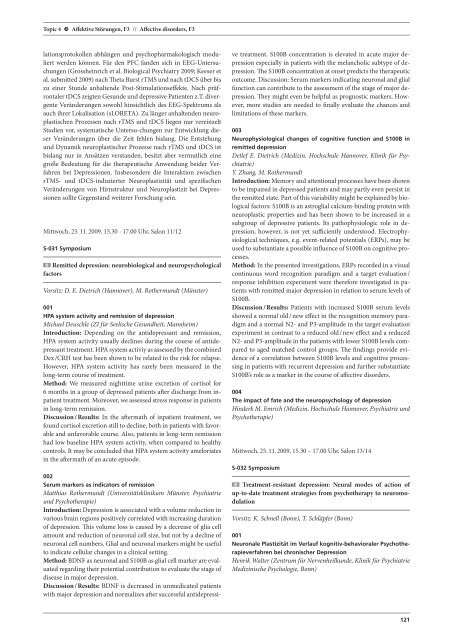Psychische Erkrankungen in der Lebensspanne ... - DGPPN
Psychische Erkrankungen in der Lebensspanne ... - DGPPN
Psychische Erkrankungen in der Lebensspanne ... - DGPPN
Sie wollen auch ein ePaper? Erhöhen Sie die Reichweite Ihrer Titel.
YUMPU macht aus Druck-PDFs automatisch weboptimierte ePaper, die Google liebt.
Topic 4 G Affektive Störungen, F3 // Affective disor<strong>der</strong>s, F3<br />
lationsprotokollen abhängen und psychopharmakologisch moduliert<br />
werden können. Für den PFC fanden sich <strong>in</strong> EEG-Untersuchungen<br />
(Grosshe<strong>in</strong>rich et al. Biological Psychiatry 2009; Keeser et<br />
al. submitted 2009) nach Theta Burst rTMS und nach tDCS über bis<br />
zu e<strong>in</strong>er Stunde anhaltende Post-Stimulationseffekte. Nach präfrontaler<br />
tDCS zeigten Gesunde und depressive Patienten z.T. divergente<br />
Verän<strong>der</strong>ungen sowohl h<strong>in</strong>sichtlich des EEG-Spektrums als<br />
auch ihrer Lokalisation (sLORETA). Zu länger anhaltenden neuroplastischen<br />
Prozessen nach rTMS und tDCS liegen nur vere<strong>in</strong>zelt<br />
Studien vor, systematische Untersu-chungen zur Entwicklung dieser<br />
Verän<strong>der</strong>ungen über die Zeit fehlen bislang. Die Entstehung<br />
und Dynamik neuroplastischer Prozesse nach rTMS und tDCS ist<br />
bislang nur <strong>in</strong> Ansätzen verstanden, besitzt aber vermutlich e<strong>in</strong>e<br />
große Bedeutung für die therapeutische Anwendung bei<strong>der</strong> Verfahren<br />
bei Depressionen. Insbeson<strong>der</strong>e die Interaktion zwischen<br />
rTMS- und tDCS-<strong>in</strong>duzierter Neuroplastizität und spezifischen<br />
Verän<strong>der</strong>ungen von Hirnstruktur und Neuroplastizit bei Depressionen<br />
sollte Gegenstand weiterer Forschung se<strong>in</strong>.<br />
Mittwoch, 25. 11. 2009, 15.30 - 17.00 Uhr, Salon 11/12<br />
S-031 Symposium<br />
Remitted depression: neurobiological and neuropsychological<br />
factors<br />
Vorsitz: D. E. Dietrich (Hannover), M. Rothermundt (Münster)<br />
001<br />
HPA system activity and remission of depression<br />
Michael Deuschle (ZI für Seelische Gesundheit, Mannheim)<br />
Introduction: Depend<strong>in</strong>g on the antidepressant and remission,<br />
HPA system activity usually decl<strong>in</strong>es dur<strong>in</strong>g the course of antidepressant<br />
treatment. HPA system activiy as assessed by the comb<strong>in</strong>ed<br />
Dex /CRH test has been shown to be related to the risk for relapse.<br />
However, HPA system activity has rarely been measured <strong>in</strong> the<br />
long-term course of treatment.<br />
Method: We measured nighttime ur<strong>in</strong>e excretion of cortisol for<br />
6 months <strong>in</strong> a group of depressed patients after discharge from <strong>in</strong>patient<br />
treatment. Moreover, we assessed stress response <strong>in</strong> patients<br />
<strong>in</strong> long-term remission.<br />
Discussion / Results: In the aftermath of <strong>in</strong>patient treatment, we<br />
found cortisol excretion still to decl<strong>in</strong>e, both <strong>in</strong> patients with favorable<br />
and unfavorable course. Also, patients <strong>in</strong> long-term remission<br />
had low basel<strong>in</strong>e HPA system activity, when compared to healthy<br />
controls. It may be concluded that HPA system activity ameloriates<br />
<strong>in</strong> the aftermath of an acute episode.<br />
002<br />
Serum markers as <strong>in</strong>dicators of remission<br />
Matthias Rothermundt (Universitätskl<strong>in</strong>ikum Münster, Psychiatrie<br />
und Psychotherapie)<br />
Introduction: Depression is associated with a volume reduction <strong>in</strong><br />
various bra<strong>in</strong> regions positively correlated with <strong>in</strong>creas<strong>in</strong>g duration<br />
of depression. This volume loss is caused by a decrease of glia cell<br />
amount and reduction of neuronal cell size, but not by a decl<strong>in</strong>e of<br />
neuronal cell numbers. Glial and neuronal markers might be useful<br />
to <strong>in</strong>dicate cellular changes <strong>in</strong> a cl<strong>in</strong>ical sett<strong>in</strong>g.<br />
Method: BDNF as neuronal and S100B as glial cell marker are evaluated<br />
regard<strong>in</strong>g their potential contribution to evaluate the stage of<br />
disease <strong>in</strong> major depression.<br />
Discussion / Results: BDNF is decreased <strong>in</strong> unmedicated pa tients<br />
with major depression and normalizes after successful antidepressi-<br />
ve treatment. S100B concentration is elevated <strong>in</strong> acute major depression<br />
especially <strong>in</strong> patients with the melancholic subtype of depression.<br />
The S100B concentration at onset predicts the therapeutic<br />
outcome. Discussion: Serum markers <strong>in</strong>dicat<strong>in</strong>g neuronal and glial<br />
function can contribute to the assessment of the stage of major depression.<br />
They might even be helpful as prognostic markers. However,<br />
more studies are needed to f<strong>in</strong>ally evaluate the chances and<br />
limitations of these markers.<br />
003<br />
Neurophysiological changes of cognitive function and S100B <strong>in</strong><br />
remitted depression<br />
Detlef E. Dietrich (Mediz<strong>in</strong>. Hochschule Hannover, Kl<strong>in</strong>ik für Psychiatrie)<br />
Y. Zhang, M. Rothermundt<br />
Introduction: Memory and attentional processes have been shown<br />
to be impaired <strong>in</strong> depressed patients and may partly even persist <strong>in</strong><br />
the remitted state. Part of this variability might be expla<strong>in</strong>ed by biological<br />
factors: S100B is an astroglial calcium-b<strong>in</strong>d<strong>in</strong>g prote<strong>in</strong> with<br />
neuroplastic properties and has been shown to be <strong>in</strong>creased <strong>in</strong> a<br />
subgroup of depressive patients. Its pathophysiologic role <strong>in</strong> depression,<br />
however, is not yet sufficiently un<strong>der</strong>stood. Electrophysiological<br />
techniques, e.g. event-related potentials (ERPs), may be<br />
used to substantiate a possible <strong>in</strong>fluence of S100B on cognitive processes.<br />
Method: In the presented <strong>in</strong>vestigations, ERPs recorded <strong>in</strong> a visual<br />
cont<strong>in</strong>uous word recognition paradigm and a target evaluation /<br />
response <strong>in</strong>hibition experiment were therefore <strong>in</strong>vestigated <strong>in</strong> patients<br />
with remitted major depression <strong>in</strong> relation to serum levels of<br />
S100B.<br />
Discussion / Results: Patients with <strong>in</strong>creased S100B serum levels<br />
showed a normal old / new effect <strong>in</strong> the recognition memory paradigm<br />
and a normal N2- and P3-amplitude <strong>in</strong> the target evaluation<br />
experiment <strong>in</strong> contrast to a reduced old / new effect and a re duced<br />
N2- and P3-amplitude <strong>in</strong> the patients with lower S100B levels compared<br />
to aged matched control groups. The f<strong>in</strong>d<strong>in</strong>gs provide evidence<br />
of a correlation between S100B levels and cognitive process<strong>in</strong>g<br />
<strong>in</strong> patients with recurrent depression and further substantiate<br />
S100B’s role as a marker <strong>in</strong> the course of affective disor<strong>der</strong>s.<br />
004<br />
The impact of fate and the neuropsychology of depression<br />
H<strong>in</strong><strong>der</strong>k M. Emrich (Mediz<strong>in</strong>. Hochschule Hannover, Psychiatrie und<br />
Psychotherapie)<br />
Mittwoch, 25. 11. 2009, 15.30 – 17.00 Uhr, Salon 13/14<br />
S-032 Symposium<br />
Treatment-resistant depression: Neural modes of action of<br />
up- to-date treatment strategies from psychotherapy to neuromodu<br />
l ati on<br />
Vorsitz: K. Schnell (Bonn), T. Schläpfer (Bonn)<br />
001<br />
Neuronale Plastizität im Verlauf kognitiv-behavioraler Psychotherapieverfahren<br />
bei chronischer Depression<br />
Henrik Walter (Zentrum für Nervenheilkunde, Kl<strong>in</strong>ik für Psychiatrie<br />
Mediz<strong>in</strong>ische Psychologie, Bonn)<br />
121


